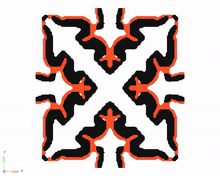Research
Negative thermal expansion meta-material
In recent years, 3D printers have become capable of multi-material fabrication, where multiple materials are used to create an object.
When two materials with different thermal expansion coefficients are stacked, bending deformation similar to that of bimetals occurs.
This is used to create a lattice structure that shows apparent planar negative thermal expansion.
From left to right are the optimal solution of the thermal deformation state (green line is the original contour), the molded specimen, and the enlarged cross-section of the specimen. In the temperature range from room temperature to bath temperature (narrow...), the CTE is less than -1*10-4.

The following is an overview of the mechanism and an animation of the thermal deformation using the finite element method. Bending deformation is converted to inward deformation at the joint by a mechanism involving a hinge.


Representative papers
- A. Takezawa, M. Kobashi, Design methodology for porous composites with tunable thermal expansion produced by multi-material topology optimization and additive manufacturing, Compos. Part B Eng., 131 (2017) 21-29.
- A. Takezawa, M. Kobashi, M. Kitamura, Porous composite with negative thermal expansion obtained by photopolymer additive manufacturing, APL Mater., 3 (7), (2015), 076103.